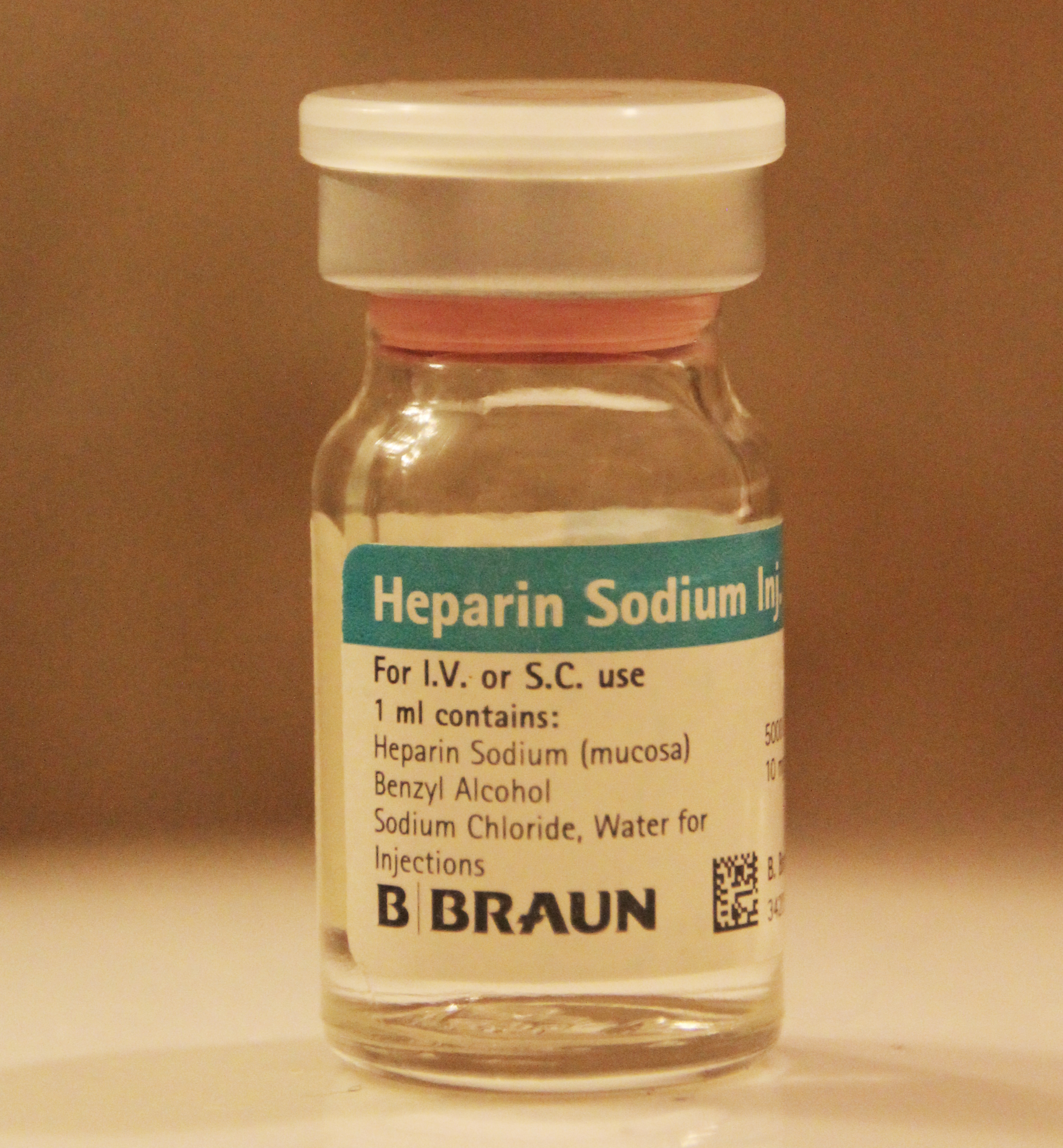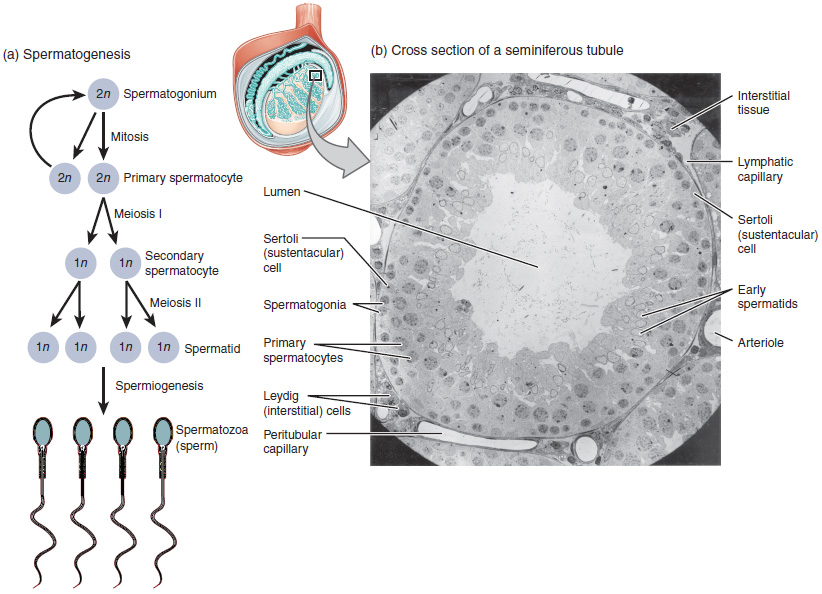|
Protamine
Protamines are small, arginine-rich, nuclear proteins that replace histones late in the haploid phase of spermatogenesis and are believed essential for sperm head condensation and DNA stabilization. They may allow for denser packaging of DNA in the spermatozoon than histones, but they must be decompressed before the genetic data can be used for protein synthesis. However, part of the sperm's genome is packaged by histones (10-15% in humans and other primates) thought to bind genes that are essential for early embryonic development. Protamine and protamine-like (PL) proteins are collectively known as the sperm-specific nuclear basic proteins (SNBPs). The PL proteins are intermediate in structure between protamine and Histone H1. The C-terminal domain of PL could be the precursor of vertebrate protamine. Spermatogenesis During the formation of sperm, protamine binds to the phosphate backbone of DNA using the arginine-rich domain as an anchor. DNA is then folded into a toroi ... [...More Info...] [...Related Items...] OR: [Wikipedia] [Google] [Baidu] |
Protamine Sulfate
Protamine sulfate is a medication that is used to reverse the effects of heparin. It is specifically used in heparin overdose, in low molecular weight heparin overdose, and to reverse the effects of heparin during delivery and heart surgery. It is given by injection into a vein. The onset of effects is typically within five minutes. Common side effects include low blood pressure, slow heart rate, allergic reactions, and vomiting. Allergic reactions may be severe and include anaphylaxis. The risk is greater in males who have had a vasectomy. While there is no evidence of harm from using during pregnancy it has not been well studied in this group. Protamine works by binding with heparin. Protamine sulfate was approved for medical use in the United States in 1969. It is on the World Health Organization's List of Essential Medicines. It was originally made from the sperm of salmon (salmine, salmon protamine). It is now mainly made using recombinant biotechnology. Medica ... [...More Info...] [...Related Items...] OR: [Wikipedia] [Google] [Baidu] |
NPH Insulin
Neutral Protamine Hagedorn (NPH) insulin, also known as isophane insulin, is an intermediate-acting insulin given to help control blood sugar levels in people with diabetes. The words refer to neutral pH (pH = 7), protamine a protein, and Hans Christian Hagedorn, the insulin researcher who invented this formulation. It is designed to improve the delivery of insulin, and is one of the earliest examples of engineered drug delivery. It is used by injection under the skin once to twice a day. Onset of effects is typically in 90 minutes and they last for 24 hours. Versions are available that come premixed with a short-acting insulin, such as regular insulin. The common side effect is low blood sugar. Other side effects may include pain or skin changes at the sites of injection, low blood potassium, and allergic reactions. Use during pregnancy is relatively safe for the fetus. NPH insulin is made by mixing regular insulin and protamine in exact proportions with zinc and phenol ... [...More Info...] [...Related Items...] OR: [Wikipedia] [Google] [Baidu] |
PRM2
Protamine 2 is a protein that in humans is encoded by the PRM2 gene. Function Protamine, Protamines substitute for Histone, histones in the chromatin of sperm during the haploid phase of spermatogenesis, and are the major DNA-binding proteins in the nucleus of sperm in many vertebrates. They package the sperm DNA into a highly condensed complex in a volume less than 5% of a somatic cell nucleus. Many mammalian species have only one protamine (protamine 1); however, a few species, including human and mouse, have two. This gene encodes protamine 2, which is cleaved to give rise to a family of protamine 2 Peptide, peptides. Alternatively spliced Alternative splicing, transcript variants have also been found for this gene. [provided by RefSeq, Sep 2015]. References Further reading * * * * * * * * {{gene-16-stub ... [...More Info...] [...Related Items...] OR: [Wikipedia] [Google] [Baidu] |
PRM1
Protamine 1 is a protein that in humans is encoded by the PRM1 gene In biology, the word gene has two meanings. The Mendelian gene is a basic unit of heredity. The molecular gene is a sequence of nucleotides in DNA that is transcribed to produce a functional RNA. There are two types of molecular genes: protei .... References Further reading * * * * * * * * * {{gene-16-stub ... [...More Info...] [...Related Items...] OR: [Wikipedia] [Google] [Baidu] |
TNP2
Nuclear transition protein 2 is a protein that in humans is encoded by the ''TNP2'' gene In biology, the word gene has two meanings. The Mendelian gene is a basic unit of heredity. The molecular gene is a sequence of nucleotides in DNA that is transcribed to produce a functional RNA. There are two types of molecular genes: protei .... References Further reading * * * * * * * * * * * {{gene-16-stub ... [...More Info...] [...Related Items...] OR: [Wikipedia] [Google] [Baidu] |
Heparin
Heparin, also known as unfractionated heparin (UFH), is a medication and naturally occurring glycosaminoglycan. Heparin is a blood anticoagulant that increases the activity of antithrombin. It is used in the treatment of myocardial infarction, heart attacks and unstable angina. It can be given intravenously or by subcutaneous injection, injection under the skin. Its anticoagulant properties make it useful to prevent blood clotting in blood specimen test tubes and kidney dialysis machines. Common side effects include bleeding, pain at the injection site, and thrombocytopenia, low blood platelets. Serious side effects include heparin-induced thrombocytopenia. Greater care is needed in those with poor kidney function. Heparin is contraindicated for suspected cases of Post-vaccination embolic and thrombotic events, vaccine-induced pro-thrombotic immune thrombocytopenia (VIPIT) secondary to SARS-CoV-2 vaccination, as heparin may further increase the risk of bleeding in an anti-PF4 ... [...More Info...] [...Related Items...] OR: [Wikipedia] [Google] [Baidu] |
Histones
In biology, histones are highly Base (chemistry), basic proteins abundant in lysine and arginine residues that are found in eukaryotic cell nuclei and in most Archaea, Archaeal Phylum, phyla. They act as spools around which DNA winds to create structural units called nucleosomes. Nucleosomes in turn are wrapped into 30-nanometer fibers that form tightly packed chromatin. Histones prevent DNA from becoming tangled and protect it from DNA damage. In addition, histones play important roles in gene regulation and DNA replication. Without histones, unwound DNA in chromosomes would be very long. For example, each human cell has about 1.8 meters of DNA if completely stretched out; however, when wound about histones, this length is reduced to about 9 micrometers (0.09 mm) of 30 nm diameter chromatin fibers. There are five families of histones, which are designated H1/H5 (linker histones), H2, H3, and H4 (core histones). The nucleosome core is formed of two H2A-H2B protein dimer ... [...More Info...] [...Related Items...] OR: [Wikipedia] [Google] [Baidu] |
Spermatogenesis
Spermatogenesis is the process by which haploid spermatozoa develop from germ cells in the seminiferous tubules of the testicle. This process starts with the Mitosis, mitotic division of the stem cells located close to the basement membrane of the tubules. These cells are called Spermatogonial Stem Cells, spermatogonial stem cells. The mitotic division of these produces two types of cells. Type A cells replenish the stem cells, and type B cells differentiate into primary spermatocytes. The primary spermatocyte divides meiotically (Meiosis I) into two secondary spermatocytes; each secondary spermatocyte divides into two equal haploid spermatids by Meiosis II. The spermatids are transformed into spermatozoa (sperm) by the process of spermiogenesis. These develop into mature spermatozoa, also known as sperm, sperm cells. Thus, the primary spermatocyte gives rise to two cells, the secondary spermatocytes, and the two secondary spermatocytes by their subdivision produce four spermatoz ... [...More Info...] [...Related Items...] OR: [Wikipedia] [Google] [Baidu] |
Transition Nuclear Protein
Transition nuclear proteins (TNPs) are proteins that are involved in the packaging of sperm nuclear DNA during spermiogenesis. They take the place of histones associated with the sperm DNA, and are subsequently themselves replaced by protamines. TNPs in humans include TNP1 and TNP2. See also * Chromatin * Histone * Protamine * Sperm * Spermatogenesis Spermatogenesis is the process by which haploid spermatozoa develop from germ cells in the seminiferous tubules of the testicle. This process starts with the Mitosis, mitotic division of the stem cells located close to the basement membrane of ... * Spermiogenesis References Andrology Reproductive system Proteins {{protein-stub ... [...More Info...] [...Related Items...] OR: [Wikipedia] [Google] [Baidu] |
Arginine
Arginine is the amino acid with the formula (H2N)(HN)CN(H)(CH2)3CH(NH2)CO2H. The molecule features a guanidinium, guanidino group appended to a standard amino acid framework. At physiological pH, the carboxylic acid is deprotonated (−CO2−) and both the amino and guanidino groups are protonated, resulting in a cation. Only the -arginine (symbol Arg or R) enantiomer is found naturally. Arg residues are common components of proteins. It is Genetic code, encoded by the DNA codon table, codons CGU, CGC, CGA, CGG, AGA, and AGG. The guanidine group in arginine is the Precursor (chemistry), precursor for the biosynthesis of nitric oxide. Like all amino acids, it is a white, water-soluble solid. The one-letter symbol R was assigned to arginine for its phonetic similarity. History Arginine was first isolated in 1886 from Lupinus luteus, yellow lupin seedlings by the German chemist Ernst Schulze (chemist), Ernst Schulze and his assistant Ernst Steiger. He named it from the Greek ''árg ... [...More Info...] [...Related Items...] OR: [Wikipedia] [Google] [Baidu] |
Herring
Herring are various species of forage fish, belonging to the Order (biology), order Clupeiformes. Herring often move in large Shoaling and schooling, schools around fishing banks and near the coast, found particularly in shallow, temperate waters of the North Pacific Ocean, North Pacific and North Atlantic Oceans, including the Baltic Sea, as well as off the west coast of South America. Three species of ''Clupea'' (the type genus of the herring family Clupeidae) are recognised, and comprise about 90% of all herrings captured in fisheries. The most abundant of these species is the Atlantic herring, which comprises over half of all herring capture. Fish called herring are also found in the Arabian Sea, Indian Ocean, and Bay of Bengal. Herring played an important role in the history of marine fisheries in Europe, and early in the 20th century, their study was fundamental to the development of fisheries science. These oily fish also have a long history as an important food fish, and ... [...More Info...] [...Related Items...] OR: [Wikipedia] [Google] [Baidu] |




